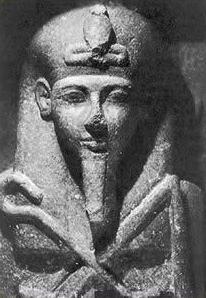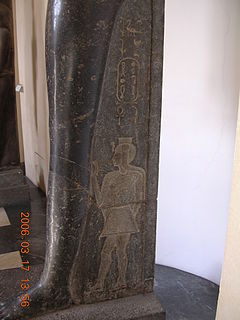
Seti II was the fifth pharaoh of the Nineteenth Dynasty of Egypt and reigned from c. 1203 BC to 1197 BC. His throne name, Userkheperure Setepenre, means "Powerful are the manifestations of Re, the chosen one of Re." He was the son of Merneptah and Isetnofret II and sat on the throne during a period known for dynastic intrigue and short reigns, and his rule was no different. Seti II had to deal with many serious plots, most significantly the accession of a rival king named Amenmesse, possibly a half brother, who seized control over Thebes and Nubia in Upper Egypt during his second to fourth regnal years.

Sitre or Tia-Sitre, was the Great Royal Wife of Pharaoh Ramesses I of Egypt and mother of Seti I.

Amenmesse was the fifth pharaoh of the Nineteenth Dynasty in Ancient Egypt, possibly the son of Merneptah and Queen Takhat. Others consider him to be one of the innumerable sons of Ramesses II. Very little is known about this pharaoh, who ruled Egypt for only three to four years. Various Egyptologists date his reign between 1202 BC–1199 BC or 1203 BC–1200 BC with others giving an accession date of 1200 BC. Amenmesse means "born of or fashioned by Amun" in Egyptian. Additionally, his nomen can be found with the epithet Heqa-waset, which means "Ruler of Thebes". His royal name was Menmire Setepenre.

Merenre Nemtyemsaf II was an ancient Egyptian pharaoh, the sixth and penultimate ruler of the 6th Dynasty. He reigned for 1 year and 1 month in the first half of the 22nd century BC, at the very end of the Old Kingdom period. Nemtyemsaf II likely ascended the throne as an old man, succeeding his long-lived father Pepi II Neferkare at a time when the power of the pharaoh was crumbling.

Akhenre Setepenre Siptah or Merenptah Siptah was the penultimate ruler of the Nineteenth Dynasty of Egypt. His father's identity is currently unknown. Both Seti II and Amenmesse have been suggested although the fact that Siptah later changed his royal name or nomen to Merneptah Siptah after his Year 2 suggests rather that his father was Merneptah. If correct, this would make Siptah and Seti II half-brothers since both of them were sons of Merneptah.
Amenherkhepshef was an ancient Egyptian prince and a son of Ramesses VI with Queen Nubkhesbed. He lived in the mid 12th century BCE during the Twentieth Dynasty of the late New Kingdom period.

Isetnofret was one of the Great Royal Wives of Pharaoh Ramesses II and was the mother of his heir, Merneptah. She was one of the most prominent of the royal wives, along with Nefertari, and was the chief queen after Nefertari's death.

Amun-her-khepeshef was the firstborn son of Pharaoh Ramesses II and Queen Nefertari.

Takhat was an ancient Egyptian princess and queen of the 19th Dynasty, the mother of the usurper pharaoh Amenmesse.

Pinedjem II was a High Priest of Amun at Thebes in Ancient Egypt from 990 BC to 969 BC and was the de facto ruler of the south of the country. He was married to his full sister Isetemkheb D and also to his niece Nesikhons, the daughter of his brother Smendes II. He succeeded Smendes II, who had a short rule.

Iset or Aset was a Princess of Egypt.

Henutmire was an ancient Egyptian princess and queen. She was one of the eight Great Royal Wives of Pharaoh Ramesses II of the 19th Dynasty of Egypt.

Tia or Tiya was an ancient Egyptian princess during the 19th Dynasty.

Khaemwaset or Khaemwase was an ancient Egyptian prince, a son of Pharaoh Ramesses III. His name can also be found as Ramesses Khaemwaset.
Merenptah was an ancient Egyptian prince during the 19th Dynasty, likely to have been a son of Pharaoh Merenptah.
Seti or Suti was an ancient Egyptian soldier during the late 18th Dynasty, the commander of the army, later mentioned as vizier on monuments of his son, Pharaoh Ramesses I.

Isetnofret was a royal woman of Ancient Egypt and, as the Great Royal Wife of Pharaoh Merenptah, she became Isetnofret II.

The Year 400 Stela, or Stela of Year 400, is an ancient Egyptian stela issued in the 13th century BCE. The meaning of this stela is not entirely clear, but is generally assumed that it celebrates the 400th anniversary of some event related to the deity Seth.
This page is based on this
Wikipedia article Text is available under the
CC BY-SA 4.0 license; additional terms may apply.
Images, videos and audio are available under their respective licenses.














